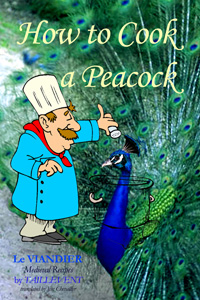CHEZ JIM
BOOKS |
How To Cook a Peacock: Medieval Recipes |
One Recipe, Several Centuries
A new collection of 18th century recipes is now available:

Serve selected dishes from a model Old Regime meal!
DARIOLESThis name was given to a custard or a pastry - or a custard IN a pastry.(Variations: daryols or darioles of cream) 14th century: Taillevent - LE VIANDIER (23)
Crush up almonds, but do not strain them. Fry the cream well in butter. Sweeten well. c. 1390: FORM OF CURY (82) Take cream of cow's milk or almond. Add eggs with sugar, saffron and salt. Mix it well. Put in a box 11 inches deep. Bake it well and serve it forth. NOTE: In the following recipes, the word 'crust' frequently corresponds to the French 'abaisse', an untranslatable term referring to rolled out dough. 1680: La Varenne - LE CUISINIER FRANCOIS (268-269) Put in a basin or a pan for example the fourth of a litron [1 litron=1.7608 British pint] of fine flour, and the white and yolk of 2 eggs: knead these things together well with a spatula or a spoon, adding a bit of milk little by little, and salt as desired; because not much is needed; soak this flour or mixture well as if it was to make gruel; and when the mixture is well kneaded, add a pint of milk which must be well mixed with the above... and if you do not have cow's milk or that of any other animal, one can use almond milk in which case one must add a bit more flour. 1814: A. Beauvilliers - L'ART DU CUISINIER (144-145) Make a crust of pie pastry the thickness of a line [1 line=a twelfth of an inch] and a half; cut it with a dough-cutter big enough that your little crusts spill over the molds of your darioles: give them the proper shapes on the point of your knife, and put them like that in these forms, wich you will have buttered; finish giving them their shape by introducing a bit of dough trim the dough spilling over the forms; for twelve darioles, put a tablespoonful of flour, six or eight macaroons or bitter marzipain. well crushed, a little salt, some orange blossom, and six raw egg yolks; knead all this with three "fish" [1 fish=1189 decimeters, or a quarter of a pint] of good milk: three quarters of n hour before serving fill your fomrs, being careful to stir the mixture; put good butter on it, the size of half a hazelnut, then cook them in the oven;: once they are cooked, take them out of the forms, lay them out on the plate, sprinkle them with fine sugare, and serve them as hot as possible. 1927 - LA CUISINE MODERNE ILLUSTREE (432) Press flaky pastry into small molds for paté in gravy; garnish them with a cream composed of 125 grams of powdered sugar, 60 grams of flour, all mixed with a wooden spoon with 6 egg yolks, a little orange water, 50 grams of melted butter and 2 deciliters of double cream. 1929: Leblanc - NOUVEAU MANUEL COMPLET DU PATISSIER (243-244) Using fine dough fill 18 small metal cups* as for patés in gravy, and put in each a little lump of butter the size of a hazelnut, then pour over it the following garnishing: |
All translations copyright 2005 Jim Chevallier.
Please do not reproduce or post elsewhere without prior permission.
Return to

recipes
Return to CHEZ JIM BOOKS